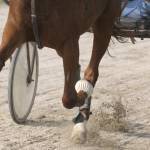Development Speeds Stem Cell Therapy for Equine Tendon Injuries

When a horse severely injures a tendon, some of the tendon fibers are torn. This causes pain, swelling, and inflammation that slowly recede as the tendon heals. The traditional treatment for a torn or “bowed” tendon in a horse’s lower limb was to stop all scheduled exercise and simply turn the horse out for a year, waiting to see whether the animal was at least serviceably sound after that period of time.
Because of misalignment of healing fibers and the inelasticity of scar tissue, a repaired tendon was rarely as strong as it was before the injury, and there was always a chance of damage recurring when the horse was put back into work. Researchers have discovered several more effective ways to treat tendon injuries, and ongoing work is refining these methods for improved results.
At the Ontario Veterinary College Health Sciences Centre, two horses with tendon injuries were some of the first equines to be treated with allogous stem cells derived from the umbilical cord blood of foals. The protocol to collect and differentiate stem cells from equine cord blood is a noninvasive process that is simpler than obtaining cells from embryos or bone marrow. So far, results have been good, with no inflammation or stem-cell rejection occurring in the recipient horses.
Using allogous stem cells allows treatment to begin much more quickly than with autologous therapy, where the horse’s own tissues are used to culture new cells for injection into the injured tendon. This procedure requires up to four weeks, while stem cells from umbilical cords can be collected, banked, and make ready for use in just a few days. As with many other injuries, treatment works best if it is begun as soon as possible after the horse has been hurt.








